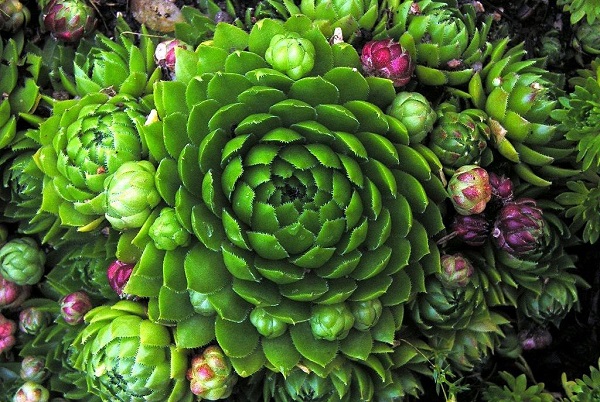Jovibarba (Joe-
Differences Between Jovibarba and Sempervivum
In this Post We'll Cover:
{Please note, some links in this post may be affiliate links to sites that pay me a small commission if you click on the link and make a purchase. This commission is at absolutely no cost to you. I only recommend products and companies that I have worked with and truly love! ~Kat}
Jovibarba and Sempervivum Debate

Jovibarba and sempervivum are very similar to sempervivum in their appearance, cold hardiness
Internationally, botanists have again filed jovibarba as a sub-genus of sempervivum. However, the Flora of North America classifies jovibarba as distinct from semps. Their
While sempervivum and jovibarba are undeniably similar, there is rich diversity within both groups. I think they both deserve to be better understood and appreciated. While genetic differences are persuasive taxonomically, it is primarily the differences in their color adaptability, flower forms and propagation that are of the most use and/or interest to the home gardener.
Jovibarba Coloring

Both sempervivum and jovibarba (especially Jovibarba heuffelii) offer wonderful color interest in the garden, ranging from deep, vivid reds and burgundies to smoky purples, many shades of pink, brilliant orange and all shades of green. Sempervivum go through extraordinary color changes due to stress through the change of seasons. One sempervivum may develop from a pale peach to bright pink to a dusky violet all within a single year. Jovibarba, however, retain far more of their vivid coloring all year long.
Jovibarba heuffeli ‘Pink Skies’ illustrates another, more subtle coloring distinction between jovibarba and sempervivum. Both varieties produce tiny little hairs along the leaf margins called ciliate hairsCiliate (SILL-ee-uht) hairs are a fringe of tiny hairs along... More. They collect dew, causing it to fall at the drip line, thereby providing the plant more moisture in an arid climate. However, the hairs on jovibarba are more pronounced and white. This gives a picotee look to each rosette as if each leaf were outlined in white. When the sun catches these hairs on the leaves, the jovibarba rosettes seem to glow. Subtle – but so lovely!
Jovibarba Flowers Compared to Sempervivum

Often the blooms of two similar looking plants help botanists and gardeners to tell them apart. Such is the case between sempervivum and jovibarba — in bloom, you can easily tell them apart. First, the similarities: Both are monocarpic succulents, meaning the mother plant (the “hen”) blooms just once, then it dies. Both produce many offsetsSucculent offsets are the baby succulents that form at the b... (the “chicks”) before blooming. The colonies continue to grow larger and lusher all the time. Sempervivum and jovibarba blooms are both highly attractive to butterflies and bees.
It is the appearance of the flowers that
Sempervivum vs Jovibarba Offsets

Another clear distinction between jovibarba and sempervivum is the way their offsets develop. All are considered “hens and chicks” because the mother plant forms many babies clustered around it. On a sempervivum, these offsets are attached by a modified stem called a stolonA stolon (STOLE-ehn) is a horizontal root, growing just abov.... In time, the
Jovibarba offsets are a bit different. Jovibarba heuffelii offsets develop within the primary rosette of the mother, between the layers of her petals. In time, if left to their own devices, they will form full-sized rosettes beside the mother plant. For the gardener to propagate at this stage requires surgery with a sharp knife — but again, this is not necessary for your collection of J. heuffelii to increase.
Jovibarba
Jovibarba & Sempervivum Pet Safe

Both sempervivum and jovibarba are completely non-toxic and safe to grow around pets and small children!
This symbol denotes pet-safe succulents. For more information about succulents and pets, just click on this image anywhere on this site.
Jovibarba for Sale Online

For such beautiful, carefree, cold hardy plants, it surprises me that sempervivum and jovibarba are not more widely available to order. However, my all-time favorite succulent source —Mountain Crest Gardens — has an exceptional selection of each. They list them all under the genus name of sempervivum, though they do use the proper species and varietal names. Even better, they separate out their selection of Jovibarba heuffelii (which they label as Sempervivum heuffelii) from their regular sempervivum. They also offer several jovibarba rollers (globifera and hirtum varieties).
I hope you have enjoyed this review of the differences between jovibarba and sempervivum. Even better, I hope you will now choose to grow both jovibarba and sempervivum in your garden! For jovibarba care, please see my post on sempervivum. Aside from propagation techniques for Jovibarba heuffelii, you’ll find all of the care essentially the same. If you have any questions or comments for me, please leave a comment. I love it when you do, and I’ll be sure to get right back with a reply!

P.S. For more succulent information and care, please subscribe to The Succulent Eclectic. You’ll also receive my FREE e-course, 7 Steps to Succulent Success!
P.P.S. Why not join my Facebook Group for succulent lovers? We talk about succulent care, propagation, succulent identification, and design. It’s a warm and welcoming group that would love to meet you!




